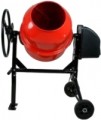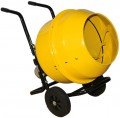Type of drive
Method for transferring torque from a cement mixer engine to a drum.
—
Crowned. The crown is called a kind of "belt" with teeth, located around the circumference of the mixing drum; the drive gear on the motor shaft engages with these teeth, thus ensuring the rotation of the cement mixer. The design of such a drive is extremely simple, which ensures both low cost and ease of maintenance and repair. The main disadvantage is the openness of the moving parts and, accordingly, the high probability of solid objects (sand, and even small gravel) getting into them, due to which the crown and gear wear out quickly. At the same time, even under adverse conditions, crown drives are able to work for quite a long time. All this has led to their high popularity in modern cement mixers.
—
Gearbox. As the name implies, the key element in the design of this drive is the gearbox — a device that reduces the rotation speed transmitted to the drum and increases the torque. Usually it is a closed unit located between the electric motor and the drum. Actually, the closeness is the main advantage of the gear drive — the body protects it from sand and other debris that can damage the mechanisms. On the other hand, most gearboxes are almost impossible to repair if they fail — the only option is to replace the entire unit, which is quite expensive. And in general, the price of such agitators is significantly higher t
...han that of models with a crown drive.Finished mixture capacity
The largest volume of mortar that can be prepared in a cement mixer at a time. Since the mixing process according to the most common gravity technology (see "Mixing type") involves an inclined position of the drum, it cannot be filled to the brim — the contents will simply pour out. Accordingly, the volume of the finished mixture anyway will be less than the total volume. The latter is also true for forced-type aggregates.
When evaluating a model with gravity mixing by the volume of the finished mixture, it must be taken into account that due to the shape of the drum, this volume cannot exceed 2/3 of the total capacity — for example, for a cement mixer with a drum of 120 liters, it will be about 80 liters. If the manufacturer indicates higher figures, then it is likely that we are talking about the theoretical amount of concrete that the engine and drive can twist in the drum without problems. This is a good indicator of reliability, but it is far from a fact that just such an amount of solution at a time can be prepared in fact.
Anyway, this parameter also plays the role of a limiter: you cannot load the cement mixer in excess of the volume of the finished mixture claimed by the manufacturer. Yes, it is likely that such a quantity of ingredients will fit in the drum, the device will not break immediately and even be able to work stably for some time. However, the mechanisms of the cement mixer in this mode will experience increased loads, which can lead t...o their premature failure; and such cases are not covered by the manufacturer's warranty.
Drum/blade speed
The speed at which the drum or blades (depending on the type of mixing, see above) move during operation of the cement mixer. In most consumer-class models, this indicator is more of a general reference than practically significant — the optimal speed for solutions that such devices usually have to work with is about 23-28 rpm, and the vast majority of models fit well into this range. The differences between specific values, usually, are completely uncritical and are due to the difference in the size of the drums and the power of the engines.
Drum tilt lock
The device fixing the drum affects the principle and convenience of unloading the finished mixture from the cement mixer.
—
Manual. Manual swivel wheel in the design of a cement mixer. To unload the mixture, it is necessary to pull it towards you, after loosening, turn the drum to the required angle of inclination of the cement mixer, and release the wheel. The load in this case falls on the hands.
—
Foot. The rotary wheel for adjusting the angle of the drum in the design of the foot lock is supplemented with an L-shaped pin or pedal, the protruding part of which is pressed by the foot. The advantage of this solution is that in order to loosen the mechanism for fixing the drum, force must be applied to pressing the "poker", and there is a minimum load on the hands.

